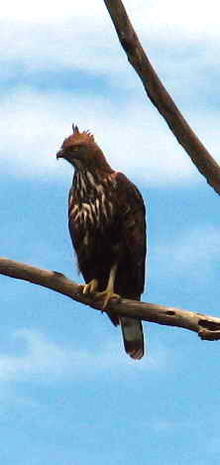- Nisaetus
-
Nisaetus 
Sri Lanka Crested Hawk-Eagle
Nisaetus cirrhatus ceylanensisScientific classification Kingdom: Animalia Phylum: Chordata Class: Aves Order: Accipitriformes Family: Accipitridae Subfamily: Buteoninae Genus: Nisaetus
Hodgson, 1836Species Nisaetus alboniger (Blyth, 1845)
Nisaetus bartelsi Stresemann, 1924
Nisaetus cirrhatus (Gmelin, 1788)
Nisaetus floris (E. Hartert, 1898)
Nisaetus kelaarti.[1]
Nisaetus lanceolatus Temminck & Schlegel, 1844
Nisaetus nanus Wallace, 1868
Nisaetus nipalensis (Hodgson, 1836)
Nisaetus philippensis Gould, 1863 Nisaetus pinskeri Preleuthner and Gamauf, 1998Nisaetus is a genus of eagles found mainly in tropical Asia. They were earlier placed within the genus Spizaetus but molecular studies show that the Old World representatives were closer to the genus Ictinaetus than to the New World Spizaetus (in the stricter sense). They are slender bodied, medium sized hawk-eagles with rounded wings, long feathered legs, barred wings, crests and usually adapted to forest habitats.[2]
Species
- Blyth's Hawk-Eagle, Nisaetus alboniger (Blyth, 1845)[3]
- Javan Hawk-Eagle, Nisaetus bartelsi Stresemann, 1924[4]
- Crested Hawk-Eagle, Nisaetus cirrhatus (Gmelin, 1788)[5]
- Flores Hawk-Eagle, Nisaetus floris (E. Hartert, 1898)[6]
- Sulawesi Hawk-Eagle, Nisaetus lanceolatus Temminck & Schlegel, 1844[7]
- Wallace's Hawk-Eagle, Nisaetus nanus Wallace, 1868[8]
- Mountain Hawk-Eagle, Nisaetus nipalensis (Hodgson, 1836)[9]
- Philippine Hawk-Eagle, Nisaetus philippensis Gould, 1863[10]
- Pinsker's Hawk-Eagle, Nisaetus pinskeri Preleuthner and Gamauf, 1998
References
- ^ Gjershaug, J. O.; Diserud, O. H.; Rasmussen, P. C. & Warakagoda, D. (2008) "An overlooked threatened species of eagle: Legge’s Hawk Eagle Nisaetus kelaarti (Aves: Accipitriformes)" (PDF) Zootaxa 1792: 54–66
- ^ E. Haring1, K. Kvaløy, J.-O. Gjershaug, N. Røv and A. Gamauf (2007). "Convergent evolution and paraphyly of the hawk-eagles of the genus Spizaetus (Aves, Accipitridae) – phylogenetic analyses based on mitochondrial markers". J Zool Syst Evol Res 45 (4): 353–365. doi:10.1111/j.1439-0469.2007.00410.x.
- ^ BirdLife International (2009). "Nisaetus alboniger". IUCN Red List of Threatened Species. Version 2010.4. International Union for Conservation of Nature. http://www.iucnredlist.org/apps/redlist/details/144513. Retrieved 18 April 2011.
- ^ BirdLife International (2009). "Nisaetus bartelsi". IUCN Red List of Threatened Species. Version 2010.4. International Union for Conservation of Nature. http://www.iucnredlist.org/apps/redlist/details/144514. Retrieved 18 April 2011.
- ^ BirdLife International (2009). "Nisaetus cirrhatus". IUCN Red List of Threatened Species. Version 2010.4. International Union for Conservation of Nature. http://www.iucnredlist.org/apps/redlist/details/150769. Retrieved 18 April 2011.
- ^ BirdLife International (2009). "Nisaetus floris". IUCN Red List of Threatened Species. Version 2010.4. International Union for Conservation of Nature. http://www.iucnredlist.org/apps/redlist/details/150770. Retrieved 18 April 2011.
- ^ BirdLife International (2009). "Nisaetus lanceolatus". IUCN Red List of Threatened Species. Version 2010.4. International Union for Conservation of Nature. http://www.iucnredlist.org/apps/redlist/details/144515. Retrieved 18 April 2011.
- ^ BirdLife International (2009). "Nisaetus nanus". IUCN Red List of Threatened Species. Version 2010.4. International Union for Conservation of Nature. http://www.iucnredlist.org/apps/redlist/details/144517. Retrieved 18 April 2011.
- ^ BirdLife International (2009). "Nisaetus nipalensis". IUCN Red List of Threatened Species. Version 2010.4. International Union for Conservation of Nature. http://www.iucnredlist.org/apps/redlist/details/144512. Retrieved 18 April 2011.
- ^ BirdLife International (2009). "Nisaetus philippensis". IUCN Red List of Threatened Species. Version 2010.4. International Union for Conservation of Nature. http://www.iucnredlist.org/apps/redlist/details/144516. Retrieved 18 April 2011.

This Falconiformes article is a stub. You can help Wikipedia by expanding it.
